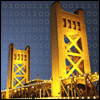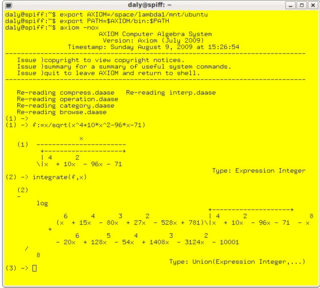
A computer program is a sequence or set of instructions in a programming language for a computer to execute. Computer programs are one component of software, which also includes documentation and other intangible components.
In computing, an optimizing compiler is a compiler that tries to minimize or maximize some attributes of an executable computer program. Common requirements are to minimize a program's execution time, memory footprint, storage size, and power consumption.

In computer science, a control-flow graph (CFG) is a representation, using graph notation, of all paths that might be traversed through a program during its execution. The control-flow graph was discovered by Frances E. Allen, who noted that Reese T. Prosser used boolean connectivity matrices for flow analysis before.
In computer science, an instruction set architecture (ISA), also called computer architecture, is an abstract model of a computer. A device that executes instructions described by that ISA, such as a central processing unit (CPU), is called an implementation.

In computer science, an interpreter is a computer program that directly executes instructions written in a programming or scripting language, without requiring them previously to have been compiled into a machine language program. An interpreter generally uses one of the following strategies for program execution:
- Parse the source code and perform its behavior directly;
- Translate source code into some efficient intermediate representation or object code and immediately execute that;
- Explicitly execute stored precompiled bytecode made by a compiler and matched with the interpreter Virtual Machine.
In computer science, algorithmic efficiency is a property of an algorithm which relates to the amount of computational resources used by the algorithm. An algorithm must be analyzed to determine its resource usage, and the efficiency of an algorithm can be measured based on the usage of different resources. Algorithmic efficiency can be thought of as analogous to engineering productivity for a repeating or continuous process.
In compiler construction, a basic block is a straight-line code sequence with no branches in except to the entry and no branches out except at the exit. This restricted form makes a basic block highly amenable to analysis. Compilers usually decompose programs into their basic blocks as a first step in the analysis process. Basic blocks form the vertices or nodes in a control-flow graph.

In computer science, a stack is an abstract data type that serves as a collection of elements, with two main operations:
Parsing, syntax analysis, or syntactic analysis is the process of analyzing a string of symbols, either in natural language, computer languages or data structures, conforming to the rules of a formal grammar. The term parsing comes from Latin pars (orationis), meaning part.
In compiler design, static single assignment form is a property of an intermediate representation (IR) that requires each variable to be assigned exactly once and defined before it is used. Existing variables in the original IR are split into versions, new variables typically indicated by the original name with a subscript in textbooks, so that every definition gets its own version. In SSA form, use-def chains are explicit and each contains a single element.
Tomasulo's algorithm is a computer architecture hardware algorithm for dynamic scheduling of instructions that allows out-of-order execution and enables more efficient use of multiple execution units. It was developed by Robert Tomasulo at IBM in 1967 and was first implemented in the IBM System/360 Model 91’s floating point unit.
PL/0 is a programming language, intended as an educational programming language, that is similar to but much simpler than Pascal, a general-purpose programming language. It serves as an example of how to construct a compiler. It was originally introduced in the book, Algorithms + Data Structures = Programs, by Niklaus Wirth in 1976. It features quite limited language constructs: there are no real numbers, very few basic arithmetic operations and no control-flow constructs other than "if" and "while" blocks. While these limitations make writing real applications in this language impractical, it helps the compiler remain compact and simple.
In computer science, computer engineering and programming language implementations, a stack machine is a computer processor or a virtual machine in which the primary interaction is moving short-lived temporary values to and from a push down stack. In the case of a hardware processor, a hardware stack is used. The use of a stack significantly reduces the required number of processor registers. Stack machines extend push-down automata with additional load/store operations or multiple stacks and hence are Turing-complete.
In compiler theory, common subexpression elimination (CSE) is a compiler optimization that searches for instances of identical expressions, and analyzes whether it is worthwhile replacing them with a single variable holding the computed value.
Data-flow analysis is a technique for gathering information about the possible set of values calculated at various points in a computer program. A program's control-flow graph (CFG) is used to determine those parts of a program to which a particular value assigned to a variable might propagate. The information gathered is often used by compilers when optimizing a program. A canonical example of a data-flow analysis is reaching definitions.
In software engineering, profiling is a form of dynamic program analysis that measures, for example, the space (memory) or time complexity of a program, the usage of particular instructions, or the frequency and duration of function calls. Most commonly, profiling information serves to aid program optimization, and more specifically, performance engineering.

GOLD is a free parsing system that is designed to support multiple programming languages.
Explicit data graph execution, or EDGE, is a type of instruction set architecture (ISA) which intends to improve computing performance compared to common processors like the Intel x86 line. EDGE combines many individual instructions into a larger group known as a "hyperblock". Hyperblocks are designed to be able to easily run in parallel.
A decompiler is a computer program that translates an executable file to high-level source code. It does therefore the opposite of a typical compiler, which translates a high-level language to a low-level language. While disassemblers translate an executable into assembly language, decompilers go a step further and translate the code into a higher level language such as C or Java, requiring more sophisticated techniques. Decompilers are usually unable to perfectly reconstruct the original source code, thus will frequently produce obfuscated code. Nonetheless, they remain an important tool in the reverse engineering of computer software.

In mathematics and computer science, computer algebra, also called symbolic computation or algebraic computation, is a scientific area that refers to the study and development of algorithms and software for manipulating mathematical expressions and other mathematical objects. Although computer algebra could be considered a subfield of scientific computing, they are generally considered as distinct fields because scientific computing is usually based on numerical computation with approximate floating point numbers, while symbolic computation emphasizes exact computation with expressions containing variables that have no given value and are manipulated as symbols.





